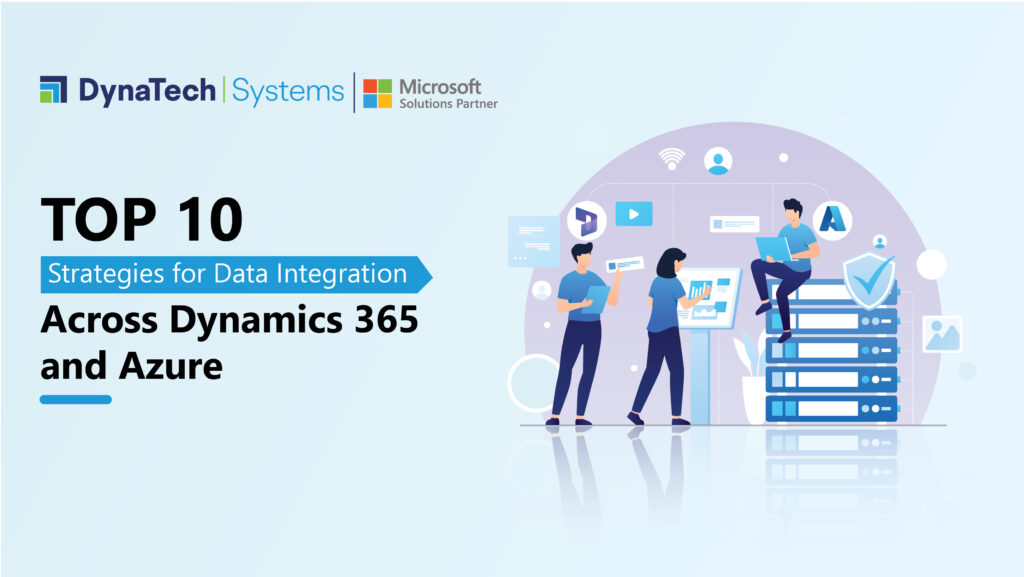Top 10 Strategies for Data Integration Across Dynamics 365 and Azure

In the digital transformation era, businesses generate massive amounts of data, and harnessing its power has become a critical success factor. Microsoft’s Dynamics 365 and Azure platforms offer powerful solutions for managing and analyzing this data. However, for organizations to truly unlock the potential of these platforms, effective data integration is paramount. In this blog, we’ll delve into the top 10 strategies for achieving seamless data integration across Dynamics 365 and Azure.
1. Define a Clear Integration Strategy
Before diving into the technicalities, it’s crucial to establish a clear integration strategy. Identify your business goals, data sources, and the desired outcomes. Are you looking to streamline business processes, improve analytics, or enhance customer experiences? Having a well-defined strategy will guide your integration efforts and ensure alignment with organizational objectives.
2. Leverage Common Data Model (CDM)
The Common Data Model acts as a lingua franca for data integration across Microsoft’s ecosystem. By standardizing data entities and definitions, CDM facilitates smooth communication between Dynamics 365 and Azure services. Utilize the predefined entities or customize them to suit your specific business requirements, ensuring consistency and coherence in your data model.
3. Implement Azure Data Factory for ETL Processes
Azure Data Factory is a robust cloud-based ETL (Extract, Transform, Load) service that plays a pivotal role in data integration. Use it to orchestrate and automate data workflows between Dynamics 365 and Azure data repositories. With its graphical interface, you can design, schedule, and monitor data pipelines, ensuring efficient data movement across systems.
4. Embrace Azure Logic Apps for Workflow Automation
Azure Logic Apps enable seamless integration by automating workflows and orchestrating business processes. Leverage its connectors for Dynamics 365 and other Azure services to create event-driven workflows. This not only enhances efficiency but also ensures real-time data synchronization, keeping your systems up-to-date and in harmony.
5. Utilize Azure Synapse Analytics for Unified Analytics
For organizations dealing with vast datasets, Azure Synapse Analytics (formerly SQL Data Warehouse) is a game-changer. This integrated analytics service allows you to analyze and visualize data across Dynamics 365 and Azure. Create a unified analytics platform that enables data exploration, reporting, and machine learning, providing valuable insights for decision-makers.
6. Employ Azure Event Grid for Real-time Integration
Real-time integration is essential for scenarios where immediate data updates are critical. Azure Event Grid facilitates the creation of event-driven architectures, ensuring seamless communication between Dynamics 365 and Azure services. With event-driven integration, you can react to changes in real-time, enhancing responsiveness and agility in your data ecosystem.
7. Secure Data with Azure Key Vault
Data security is a non-negotiable aspect of data integration. Azure Key Vault provides a centralized repository to store and manage sensitive information such as connection strings and authentication keys. By integrating Azure Key Vault into your data integration strategy, you ensure that sensitive information remains protected, reducing the risk of unauthorized access.
8. Implement Change Data Capture (CDC) for Efficient Updates
Change Data Capture is a strategy that identifies and captures changes made to data in source systems. By implementing CDC, you can optimize data integration processes by focusing on the modified data, reducing the volume of data transferred between Dynamics 365 and Azure. This approach enhances efficiency and minimizes the impact on system resources.
9. Monitor and Optimize Performance with Azure Monitor
Effective data integration requires continuous monitoring to identify bottlenecks, anomalies, and potential issues. Azure Monitor provides comprehensive monitoring capabilities, allowing you to track the performance of your integration workflows. Utilize its features to gain insights into resource utilization, detect anomalies, and optimize your data integration processes for peak efficiency.
10. Ensure Scalability with Azure Integration Services
As your business grows, so does the volume of data. Azure Integration Services offers a scalable and flexible platform to accommodate the increasing data integration demands. Whether dealing with a growing customer base or expanding product lines, Azure Integration Services enables you to scale your integration architecture seamlessly, ensuring continued performance and reliability.
Conclusion
In conclusion, achieving seamless data integration across Dynamics 365 and Azure requires a strategic and well-executed approach. By adopting these top 10 strategies, enterprises can unleash the full potential of their data to drive innovation, boost productivity, and gain a competitive edge in the ever-evolving digital landscape.

